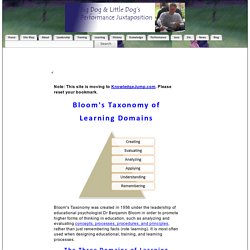

The Best Resources For Helping Teachers Use Bloom’s Taxonomy In The Classroom. Bloom’s & SOLO ‘are not Just Colorful Posters we Hang on the Wall’ is my two-part series at Education Week Teacher.

Bloom’s Taxonomy is talked about a lot in educational circles. However, if you believe a recent survey of visits to 23,000 U.S. classrooms, the higher-order thinking skills it’s ideally designed to promote doesn’t get much use. And I can understand why. It’s easy to get caught-up in the day-to-day work involved in teaching a class or multiple classes, and it’s easy to fall into the trap of doing the “usual stuff” and not “think out of the box.” I thought it might be useful to share in a “The Best…” list the resources that help me try to use Bloom’s Taxonomy in my classroom.
There may very well be resources out there that do a far better job of explaining the Taxonomy and how to use it. I personally try to use Bloom’s Taxonomy in two ways. In addition, I try to use Bloom’s to help me formulate my own lessons. University of Victoria - Counselling Services. Bloom's Taxonomy of Learning Domains. Note: This site is moving to KnowledgeJump.com.

Please reset your bookmark. Bloom's Taxonomy was created in 1956 under the leadership of educational psychologist Dr Benjamin Bloom in order to promote higher forms of thinking in education, such as analyzing and evaluating concepts, processes, procedures, and principles, rather than just remembering facts (rote learning). It is most often used when designing educational, training, and learning processes. The Three Domains of Learning The committee identified three domains of educational activities or learning (Bloom, et al. 1956): Cognitive: mental skills (knowledge) Affective: growth in feelings or emotional areas (attitude or self) Psychomotor: manual or physical skills (skills) Bloom's Taxonomy. Bloom's Digital Taxonomy. The Best Resources For Helping Teachers Use Bloom’s Taxonomy In The Classroom.
Definitions of Bloom's Taxonomy. Activities at Various Cognitive Levels of Learning (LoL) Bloom’s taxonomy of learning objectives is used to define how well a skill or competency is learned or mastered.

A fuller description of Bloom’s taxonomy is given in the following pages but a brief summary of the activities associated with each level is given below. At Knowledge Level of Learning a student can define terms At Comprehension Level of Learning a student can work assigned problems and can example what they did At Application Level of Learning a student recognizes what methods to used and then used the methods to solve problems At Analysis Level of Learning a student can explain why the solution process works At Synthesis Level of Learning a student can combine the part of a process in new and useful ways At Evaluation Level of Learning a student can create a variety of ways to solve the problem and then, based on established criteria, select the solution method best suited for the problem.
What do I do at this level? Edorigami.wikispaces.com/file/view/Blooms+activity+analysis+2.pdf. Applying Bloom's Taxonomy. Major Categories in the Taxonomy of Educational Objectives. Knowledge remembering of previously learned material; of terminology; specific facts; ways and means of dealing with specifics (conventions, trends and sequences, classifications and categories, criteria, methodology); universals and abstractions in a field (principles and generalizations, theories and structures): Knowledge is (here) defined as the remembering (recalling) of appropriate, previously learned information.

Defines; describes; enumerates; identifies; labels; lists; matches; names; reads; records; reproduces; selects; states; views; writes;. Comprehension: Grasping (understanding) the meaning of informational materials. Classifies; cites; converts; describes; discusses; estimates; explains; generalizes; gives examples; illustrates; makes sense out of; paraphrases; restates (in own words); summarizes; traces; understands. Application: The use of previously learned information in new and concrete situations to solve problems that have single or best answers.
Activities for Each Level of Bloom's Taxonomy.